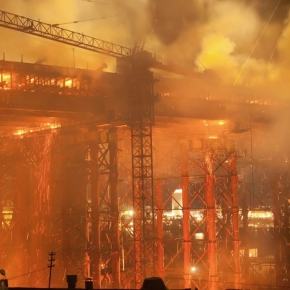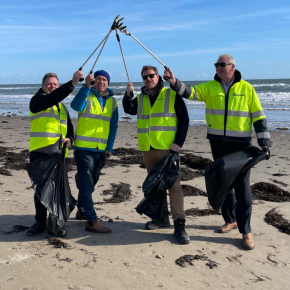
Bull’s tips to prevent a fire spreading on your construction site
Bull Products has shared its guide on how to prevent a fire from spreading on a construction site.
Implement the right products
Implementing the correct fire safety products is vital to prevent a fire from spreading and fire extinguishers are one of the most life-saving products to have on site.
Fire extinguishers should be located at identified fire points around the site and should be appropriate to the nature of the potential fire:
- Wood, paper and cloth – water extinguisher
- Flammable liquids – dry powder or foam extinguisher
- Electrical – carbon dioxide (C02) extinguisher
Consider how to detect fires
On a smaller site, a standalone alarm unit may be sufficient but as a construction site grows, there is a higher risk of a fire breaking out.
The installation of fire detection and wireless alarm systems, you can ensure workers are alerted in the event of a fire.
Bull’s Cygnus mobile detection device is an ideal solution for instant fire detection warning and can be used in conjunction with the Fire First Responder Station which connects the detector (smoke or heat) to the alarm on the station.
It is suitable for temporary hot works, as it can be moved to where the hazard is and then left there for a period of time to guarantee a fire does not start.
Carry out thorough staff training
It is crucially important to ensure staff are confident when using any type of fire safety equipment – they need to know what risks to be aware of and what actions to take in the event of a fire. All new employees should also receive fire safety training.
Review and update your risk assessment
According to The Regulatory Reform (Fire Safety) Order 2005 (FSO), a ‘responsible person’ must carry out, and keep up to date, a risk assessment and implement appropriate measures to lower the risk to life and property from fire.
The HSE recommends following these five steps when carrying out a fire risk assessment:
- Identify hazards: consider how a fire could start and what could burn
- Identify those at risk: employees, contractors, visitors and anyone who is vulnerable
- Evaluation and action: consider the hazards and people identified in 1 and 2 and act to remove and reduce risk to protect people and premises
- Record, plan and train: keep a record of the risks and action taken. Make a clear plan for fire safety and ensure that people understand what they need to do in the event of a fire
- Review: your assessment regularly and check it takes account of any changes on site.
By following these four tips, you can prevent a fire from spreading, which will protect your workers and site in the long-term.
Latest news

11th April 2025
Don’t Do a Dave! It’s Time to Lock FIT Show 2025 in Your Calendar!
It’s that time again – FIT Show is back! You could be forgiven for thinking there won’t be much new to see when FIT Show returns to the NEC from 29 April – 1 May. Wrong!
Posted in Articles, Building Industry Events, Building Industry News, Building Products & Structures, Building Services, Continuing Professional Development (CPD's), Exhibitions and Conferences, Information Technology, Innovations & New Products, Restoration & Refurbishment, Retrofit & Renovation, Seminars, Training
11th April 2025
Insight Data: Boost construction success with project and prospect data
For those working in construction – in whatever capacity – the last few years haven’t been much fun. And according to the latest statistics, it would seem the challenges are continuing – Alex Tremlett, Insight Data’s Commercial Director, has more…
Posted in Articles, Building Industry News, Building Services, Information Technology, news, Research & Materials Testing
11th April 2025
ASSA ABLOY EMEIA: Learn how to tackle the security challenges of digitalising access with insights from industry experts
In a new series of videos, experts in various specialisms within ASSA ABLOY share their expertise on digital access, including the complexities to overcome and the range of benefits for those who get digital access right…
Posted in Access Control & Door Entry Systems, Architectural Ironmongery, Articles, Building Industry News, Building Products & Structures, Building Services, Doors, Facility Management & Building Services, Information Technology, Innovations & New Products, Posts, Restoration & Refurbishment, Retrofit & Renovation, Security and Fire Protection, Videos
10th April 2025
Geberit completes 150 Acts of Kindness
Geberit has raised nearly £14,000 for various charities through its ‘150 Acts of Kindness’ initiative, a year-long programme of fundraising and volunteering to mark the company’s 150th anniversary in 2024.
Posted in Articles, Bathrooms & Toilets, Bathrooms, Bedrooms & Washrooms, Building Industry Events, Building Industry News, Building Products & Structures, Building Services, Charity work, Drainage, Interiors, Pipes, Pipes & Fittings, Plumbing, Restoration & Refurbishment, Retrofit & Renovation
 Sign up:
Sign up: 